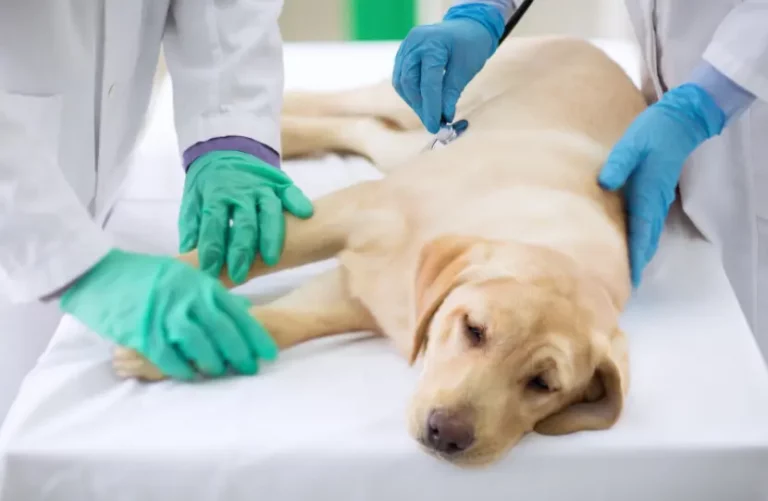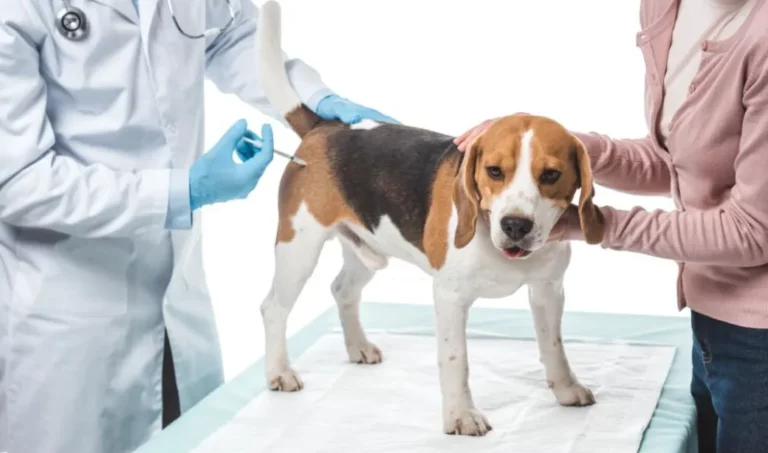Common Genetic Disorders in Dogs
Genetic disorders are not a common illness among the dogs. It should be noted that some of these conditions are more common in specific breeds because they are passed on through their bloodlines.
Depending on the type of genetic disease, there are various ways that diseases can be inherited from one generation to the next, and they may either be dominant or recessive.

Table of Contents
- Canine Hip Dysplasia
- Canine cranial cruciate ligament rupture
- Brachycephalic obstructive airway syndrome
- Canine degenerative myelopathy
- Common canine heart diseases
- Canine chondrodysplasia
- Urinary bladder stones in dogs
- Inherited epilepsy in dogs
- Allergic skin disease and deafness in dogs
- Progressive retinal atrophy and other inherited eye diseases in dogs
- Additional common genetic diseases in dogs
- FAQ
Canine Hip Dysplasia
Canine Hip Dysplasia affects over 74 million dogs worldwide. This inherited skeletal disorder prevents the ball and socket joints in a dog’s hips from aligning properly. The bones rub together, causing cartilage damage, inflammation, stiffness, and arthritis.
While all dog breeds can develop hip dysplasia, the disorder most commonly impacts larger breeds. According to the Orthopedic Foundation for Animals (OFA), the species with the highest dysplastic rates in 2022 were Mastiffs at 61.2%, Newfoundlands at 44.3%, Rottweilers at 35.9%, Bernese Mountain Dogs at 32.3%, and Great Danes at 31.5%.
Both genetic and environmental factors influence a dog’s chance of developing hip dysplasia. Carrying excess weight, overexercising during growth spurts, and improper nutrition can exacerbate the inherited Genes. According to the OFA, dogs with dysplastic parents have a 15-60% chance of developing the condition.
Treatment options range from nonsurgical to surgical, depending on the severity of dysplasia. Mild cases may involve joint supplements, nonsteroidal anti-inflammatory drugs (NSAIDs), or low-impact exercise. More severe dysplasia requires total hip replacement surgery, costing $6000+ per hip. Early screening and preventative care are vital to minimizing hip dysplasia impacts in susceptible breeds.
Canine cranial cruciate ligament rupture
Cranial cruciate ligament (CCL) rupture is a common knee injury in dogs that causes severe hind limb lameness. Over 1.2 million dogs suffer CCL tears annually in the United States.
The CCL is a fibrous band that connects the femur to the tibia, stabilizing the knee joint. When torn, the femur and tibia shift abnormally, causing intense pain and an inability to bear weight on the affected leg. Dogs may lift their leg while standing or walking and avoid placing their foot on the ground.
CCL rupture results from both genetic and environmental factors. Breeds prone to CCL tears include “Labrador Retrievers, Newfoundlands, Mastiffs, and Rottweilers“. Obesity and intense physical activity are key risk factors, especially in young dogs. The CCL deteriorates with age, making geriatric dogs more susceptible as well.
Veterinarians diagnose CCL tears through physical exams and imaging tests. They manipulate the knee joint to check for abnormal shifting indicative of complete CCL rupture. Surgery is often necessary to stabilize the joint and prevent progressive osteoarthritis, costing $ 3,000-$ 5,000 per knee. Non-surgical options like braces may help some small dogs under 30 pounds (14 kg). But without treatment, the knee joint progressively deteriorates.
Brachycephalic obstructive airway syndrome
Brachycephalic obstructive airway syndrome (BOAS) impacts 42 dog breeds with pushed-in facial features, like Pugs, French Bulldogs, and Boston Terriers. Their short snouts and narrowed airways make breathing difficult.
Affected dogs chronically struggle for air. They snort, wheeze, snore, and gag due to obstructed airflow. BOAS also predisposes dogs to overheating and heatstroke due to impaired panting.
According to veterinary studies, 95% of English Bulldogs and 50% of French Bulldogs suffer from BOAS. The syndrome commonly manifests as elongated soft palates, narrowed nostrils, and everted laryngeal sacks obstructing the throat.
BOAS can lead to serious secondary conditions, including pulmonary hypertension, pneumonia, and cardiac distress. Corrective surgeries like soft palate resection, laryngeal tie-back, and nostril widening can improve airway anatomy.
Caring for brachycephalic dogs requires diligent monitoring for respiratory distress, especially in warm weather. Their facial structure also predisposes them to dental overcrowding, eye issues, and skin fold infections.
Canine degenerative myelopathy
Degenerative myelopathy (DM) is a progressive spinal cord disease that impacts older dogs. It results from the deterioration of the myelin sheath surrounding nerve fibers in the lower back. This leads to hind limb weakness, difficulty standing, and eventual paralysis.
DM most often affects large dog breeds like German Shepherds, Boxers, Siberian Huskies, and Pembroke Welsh Corgis. According to the Canine Health Foundation, DM impacts approximately 9.5% of German Shepherds. Onset is typically between 8-14 years of age.
There is no cure for DM, only supportive care. Dogs may use harnesses, carts, or slings to maintain mobility as long as possible. Progression to paralysis typically occurs over 9-18 months. DM does not cause pain but carries a significant emotional burden for dogs and owners.
A genetic test can identify dogs that carry DM risk factors. However, the test is not yet widely available. Responsible breeders should screen breeding dogs to reduce DM prevalence. Early signs include dragging toes, knuckling of the hindlimbs, and uncoordinated hind movements.
Common canine heart diseases
Heart disease is prevalent across dog breeds, though certain conditions disproportionately impact some. According to veterinary studies, over 10% of all dogs develop heart disease.

Dilated Cardiomyopathy (DCM)
- Impacts large breeds like Doberman Pinschers, Irish Wolfhounds, and Great Danes
- Heart muscle walls thin, and chambers enlarge
- Results in weak heart contractions and congestive heart failure
- Affects 25-50% of Dobermans
Arrhythmogenic Right Ventricular Cardiomyopathy (ARVC)
- Impacts Boxers, English Bulldogs, German Shepherds
- Fatty/fibrous tissue replaces heart muscle
- Causes irregular heart rhythms (arrhythmias)
- Can result in sudden cardiac death
Myxomatous Mitral Valve Disease
- Most common in small breeds like Cavalier King Charles Spaniels
- Mitral valve leaflets deteriorate and leak
- >50% of Cavaliers develop the disease
- This leads to an enlarged heart and eventually congestive heart failure
Signs of canine heart disease include coughing, weakness, exercise intolerance, fainting, and abdominal swelling. Veterinary evaluation and treatment are critical upon symptom onset to slow disease progression.
Canine chondrodysplasia
Chondrodysplasia is a genetic cartilage and bone growth disorder that disproportionately affects short-legged dog breeds like Basset Hounds, Dachshunds, Corgis, and Bulldogs.
It results from a mutation in the ITGA10 gene in cartilage collagen formation. This disrupts the normal development of the long bones in the limbs, spine, and ribs.
Signs include stunted limb growth, spinal malformations, swollen joints, osteoarthritis, and intervertebral disc disease. However, carriers show no outward symptoms, making genetic screening critical.
The mutation follows an autosomal recessive inheritance pattern. Puppies only develop chondrodysplasia if they inherit two copies of the defective gene – one from each parent. According to studies, 32% of Basset Hounds carry single copies.
Breeding two carrier Bassets poses a 25% risk of producing affected puppies with two mutated copies. Responsible breeders genetically test breeding dogs and avoid carrier-to-carrier matings.
Early diagnosis and tailored exercise/therapy can improve the quality of life for affected dogs. However, there is no cure for abnormalities caused by chondrodysplasia.
Urinary bladder stones in dogs
Bladder stones, also called uroliths or cystic calculi, are mineral formations that develop in the urinary bladder. They typically consist of struvite, calcium oxalate, or urate compounds.

In the US, over 1 million dogs develop bladder stones annually. Miniature Schnauzers, Bichon Frises, Shih Tzus, and Dalmatians have a genetic predisposition. Stones also occur secondary to bladder infections or metabolic disorders.
Stones vary in size from microscopic crystals to golf ball-sized formations that cause urinary obstruction. Common signs are blood in urine, straining, and frequent/painful urination.
Treatment often involves surgical removal or non-surgical dissolution of the stones. Analyzing stone composition helps guide dietary therapy to prevent recurrence. Prescription urinary diets that alter urine pH and mineral content may be recommended.
Preventative measures like increased water intake, limited protein/mineral intake, and urinary alkalinizers can help minimize stone risk in susceptible breeds. Routine veterinary screening is advised to catch stones early before they cause significant complications.
puppiesdiary.com
Inherited epilepsy in dogs
Epilepsy is a chronic neurological disorder characterized by recurrent, uncontrolled seizures. It’s one of the most common canine brain diseases, with a 0.5-5% prevalence in the general dog population.
Certain breeds have an inherited predisposition to epilepsy, including Beagles, German Shepherds, Belgian Tervurens, Keeshonds, and Dachshunds. However, the precise genetic basis is complex and not fully understood.
Most dogs experience their first seizure between 1-5 years of age. Seizure types, frequency, and progression are similar within an affected breed, suggesting a shared genetic origin. However, studies show that neither single-gene nor simple recessive/dominant inheritance patterns are likely.
Polygenic inheritance and environmental factors like head trauma likely contribute. Breeding two dogs with epilepsy poses a high risk of producing affected offspring.
Anticonvulsant drugs like phenobarbital and potassium bromide can help control seizures. About 70% of treated dogs have a 50% or greater reduction in seizure frequency. Though lifelong medication is often required, many dogs can enjoy a good quality of life with veterinary management.
Allergic skin disease and deafness in dogs
Allergic Skin Disease
- Caused by environmental or food allergies
- Results in chronic itchy skin (pruritis)
- It affects breeds like Dalmatians, Golden Retrievers, Labradors
- Signs include paw licking, ear/skin infections, hair loss
- Treated through allergen avoidance, medications
Hereditary Deafness
- Impacts breeds with white coat coloration
- 80% of Dalmatians have hearing impairment
- Caused by lack of pigment cells in the inner ear
- Also common in Boxers, English Setters, Bull Terriers,
- Signs appear from birth to 8 weeks old
- No treatment exists to restore hearing
While many skin allergies are acquired, certain breeds have a hereditary predisposition. Responsible breeders should screen for allergies and deafness before breeding dogs of high-risk breeds. Proper management and lifestyle adjustments can help affected dogs live happily. However, deafness and severe allergic disease can be challenging lifelong conditions.
How Can I Treat A Hole In My Dog’s Skin? [3 Hidden Tips To Fast Cure]
puppiesdiary.com
Progressive retinal atrophy and other inherited eye diseases in dogs
Progressive retinal atrophy (PRA) is a group of genetic eye disorders that cause blindness through deterioration of the retina’s photoreceptor cells. Over 100 dog breeds are affected, including Labrador Retrievers, Collies, and American Eskimo Dogs.
Multiple forms of PRA are breed-specific. The age of onset, progression rate, and photoreceptor loss pattern vary between breeds. Most forms follow an autosomal recessive inheritance pattern.
Signs begin with night blindness, followed by peripheral and daytime vision loss as the disease advances. Most dogs are blind by 3-5 years old. There is no treatment, only genetic screening to guide breeding programs.
Other inherited eye diseases like collie eye anomaly affect Collie, Shetland Sheepdog, and Australian Shepherd breeds. Changes include underdeveloped retinas and optic nerve damage. Approximately 70% of Collies carry the mutation.
Responsible breeders have veterinary ophthalmologists evaluate dogs before breeding to reduce the incidence of preventable inherited eye disorders. Routine eye exams help detect disease early to slow progression in affected dogs.
Additional common genetic diseases in dogs
Myotonia Congenita
- Causes muscle stiffness and fainting episodes
- Affects Chow Chows, Cocker Spaniels, Labradors
- Prevalence in Miniature Schnauzers is 10-18%
Hypothyroidism
- Thyroid hormone deficiency due to autoimmune disorder
- Impacts over 80 breeds, including Golden Retrievers
- Around 10% of Scotties and 18% of Retrievers affected
Gastric Dilatation-Volvulus (GDV/Bloat)
- Life-threatening stomach twisting
- Most common in large, deep-chested breeds
- Incidence in Standard Poodles is over 20%
- Genetic predisposition but not directly inherited
Identifying breed-specific disease risks allows for early detection and prevention. Routine veterinary care, genetic screening of breeding dogs, and lifestyle modifications can help minimize impacts. However, widespread genetic disease in purebreds remains an ethical concern in certain breeds.
FAQ
How can I reduce my dog’s risk for genetic disease?
Carefully research breed-specific disorders and only get your dog from responsible breeders who screen their breeding dogs. Feed a healthy diet, avoid obesity, don’t over-exercise young dogs, and have yearly vet exams to catch issues early. Consider pet insurance for financial assistance.
Is it safe to breed dogs that carry genetic mutations?
No, breeding dogs with disease-associated mutations can produce puppies that inherit two copies of the mutation and develop the disease. Ethical breeders genetically test dogs and avoid matings between carriers to minimize this risk. Testing allows carriers to be identified so they are not bred.



![What does it mean if a dog has sticky urine? [8 Reasons reveal] 6 What does it mean if a dog has sticky urine? [8 Reasons reveal]](https://www.puppiesdiary.com/wp-content/uploads/2023/04/What-does-it-mean-if-a-dog-has-sticky-urine-768x457.webp)

![Canine Epilepsy Symptoms, Stages, Diagnosis, And Treatment Process [Vet Advice] 8 Canine Epilepsy Symptoms, Stages, Diagnosis, And Treatment Process [Vet Advice]](https://www.puppiesdiary.com/wp-content/uploads/2023/11/Canine-Epilepsy-Stages-768x528.jpg)
